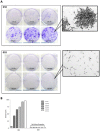The role of TP53 gain-of-function mutation in multifocal glioblastoma
- PMID: 32002804
- PMCID: PMC7075848
- DOI: 10.1007/s11060-019-03318-5
The role of TP53 gain-of-function mutation in multifocal glioblastoma
Abstract
Purpose: The phenotypic and genotypic landscapes in multifocal glioblastoma (MF GBM) cases can vary greatly among lesions. In a MF GBM patient, the rapid development of a secondary lesion was investigated to determine if a unique genetic signature could account for the apparent increased malignancy of this lesion.
Methods: The primary (G52) and secondary (G53) tumours were resected to develop patient derived models followed by functional assays and multiplatform molecular profiling.
Results: Molecular profiling revealed G52 was wild-type for TP53 while G53 presented with a TP53 missense mutation. Functional studies demonstrated increased proliferation, migration, invasion and colony formation in G53.
Conclusion: This data suggests that the TP53 mutation led to gain-of-function phenotypes and resulted in greater overall oncogenic potential of G53.
Keywords: Gain-of-function; Glioblastoma; Multifocal; TP53.
Conflict of interest statement
The authors have declared no conflict of interest.
Figures





Similar articles
-
TP53 gain-of-function mutation promotes inflammation in glioblastoma.Cell Death Differ. 2019 Mar;26(3):409-425. doi: 10.1038/s41418-018-0126-3. Epub 2018 May 21. Cell Death Differ. 2019. PMID: 29786075 Free PMC article.
-
Elevation of the TP53 isoform Δ133p53β in glioblastomas: an alternative to mutant p53 in promoting tumor development.J Pathol. 2018 Sep;246(1):77-88. doi: 10.1002/path.5111. Epub 2018 Jul 31. J Pathol. 2018. PMID: 29888503 Free PMC article.
-
Detection of p53 mutations in proliferating vascular cells in glioblastoma multiforme.J Neurosurg. 2015 Feb;122(2):317-23. doi: 10.3171/2014.10.JNS132159. Epub 2014 Nov 21. J Neurosurg. 2015. PMID: 25415071
-
PARP1 expression and its correlation with survival is tumour molecular subtype dependent in glioblastoma.Oncotarget. 2017 Jul 11;8(28):46348-46362. doi: 10.18632/oncotarget.18013. Oncotarget. 2017. PMID: 28654422 Free PMC article.
-
Genetic pathways to primary and secondary glioblastoma.Am J Pathol. 2007 May;170(5):1445-53. doi: 10.2353/ajpath.2007.070011. Am J Pathol. 2007. PMID: 17456751 Free PMC article. Review.
Cited by
-
Molecular targeted therapy: A new avenue in glioblastoma treatment.Oncol Lett. 2022 Dec 15;25(2):46. doi: 10.3892/ol.2022.13632. eCollection 2023 Feb. Oncol Lett. 2022. PMID: 36644133 Free PMC article. Review.
-
Pediatric Giant Cell Glioblastoma Presenting with Intracranial Dissemination at Diagnosis: A Case Report.NMC Case Rep J. 2021 Jun 5;8(1):151-157. doi: 10.2176/nmccrj.cr.2020-0138. eCollection 2021. NMC Case Rep J. 2021. PMID: 35079457 Free PMC article.
-
The therapeutic potential of pegylated arginase I treatment in glioblastoma.Sci Rep. 2025 Aug 8;15(1):28994. doi: 10.1038/s41598-025-13882-8. Sci Rep. 2025. PMID: 40774999 Free PMC article.
-
Deciphering the role of transcription factors in glioblastoma cancer stem cells.Acta Biochim Biophys Sin (Shanghai). 2024 May 8;56(9):1245-1255. doi: 10.3724/abbs.2024061. Acta Biochim Biophys Sin (Shanghai). 2024. PMID: 38716541 Free PMC article. Review.
-
Patterns of care and survival in patients with multifocal glioblastoma: A Danish cohort study.Neurooncol Pract. 2024 Mar 9;11(4):421-431. doi: 10.1093/nop/npae020. eCollection 2024 Aug. Neurooncol Pract. 2024. PMID: 39006522 Free PMC article.
References
MeSH terms
Substances
LinkOut - more resources
Full Text Sources
Other Literature Sources
Medical
Research Materials
Miscellaneous

